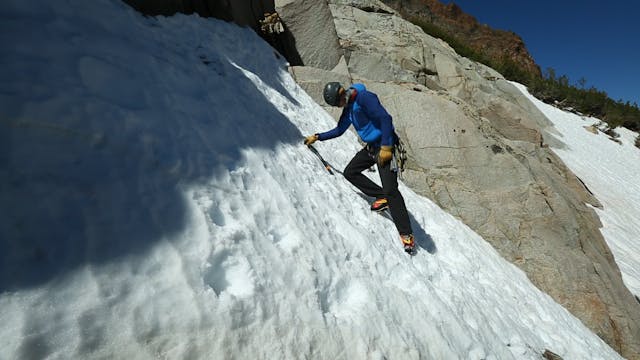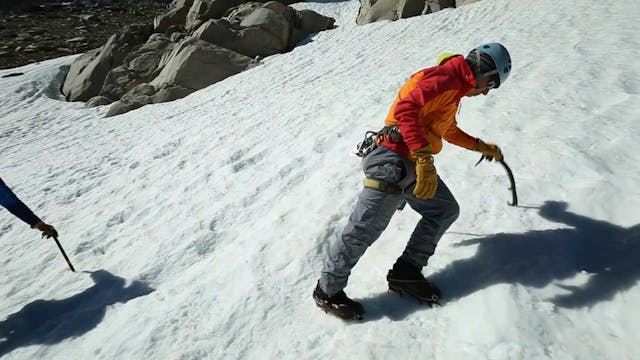Alpine: 6. Snow Travel Considerations
Alpine & Mountaineering
•
2m 49s
Snow is an incredible medium on which to travel, and often provides efficient travel conditions. In this video, we look at various aspects of climbing on snow.
Perfect spring “corn” snow that is well consolidated and soft enough to take a boot kick or ski edge, or firmer snow that takes crampon points (almost like kicking into styrofoam!), can both be fun snow climbing.
Conditions can both make and break your climbing experience. A thin layer of snow covering a talus field can be treacherous. And deep, unconsolidated powder snow, or rotten spring isothermal snow, can lead to waist-deep postholing and exhausting travel in the mountains.
Snow changes both on a seasonal level throughout the year, as well as on a diurnal cycle with cold nights and warm days.
Autumn - the mountains have the least amount of snow, and many lower elevation glaciers and talus fields are free of snow.
Winter - the snowpack starts to build as storms deposit more and more snow. Winter snow tends to be softer and less supportable, so most climbers will don skis or snowshoes. In popular winter ice climbing areas that get a lot of traffic, boot packed trails can allow access through snowy areas without the use of snowshoes or skis.
Spring - can lead to some great climbing conditions, when solar radiation and cold overnight temps combine into a melt freeze cycle that creates smooth, buttery “corn” snow. In spring, snow travel may still be better with skis and skins, assuming the objective you wish to climb has good snow coverage on the approach.
Summer - allows for “neve” snow climbing conditions, where the snow that exists becomes consolidated, and slowly melts away. Late in the summer, “suncups” can form in the snow surface. These can be less fun to deal with.
The spring diurnal cycle often makes for excellent climbing conditions overnight, or very early in the morning, when the snow surface is still frozen. Later in the morning there will be a sweet spot where the snow still holds a boot edge, but it is soft enough to ski, glissade, or boot glissade. Later in the afternoon, the warming may penetrate deep enough into the snowpack to make it “rotten,” so you post hole to your hip.
If the snow is firm or icy, crampons are the best—especially if the terrain is steep. Though crampons are more secure, they can be problematic if the snow is soft. If you notice snow balling under the bottoms of the crampons, climbing or descending snow in boots without crampons may be better—assuming you can get enough purchase (i.e. traction) with your boots.
We hope you found this video helpful. Feel free to comment below with questions or thoughts!
Please remember, climbing is inherently dangerous. Climb at your own risk.
Up Next in Alpine & Mountaineering
-
Alpine: 7. Efficient Snow Travel
When getting into mountaineering, it is worth it to invest time in learning and practicing the most efficient stepping techniques. Mountains can be huge, and involve lots of steps. The more efficient you are with each one, the further you will be able to climb.
As the saying goes: how do you e...
-
Alpine: 8. Changing Directions in Snow
Let’s look at how to change directions when climbing steep snow slopes. When switchbacking up a steep snow slope, you will obviously have to change directions—multiple times!
Here are the steps for changing direction, while maintaining a self belay with the ice axe for security:
Step 1: Ta...
-
Alpine: 9. Crampon Anti-Balling Plates
In this video we discuss crampon anti-balling plates. Snow can stick to the bottom of your crampons, especially in wet snow conditions. After a few steps, you’ll feel like you’re walking on slippery (and heavy) platform shoes, and your sharp points will be useless.
One solution that manufactur...


